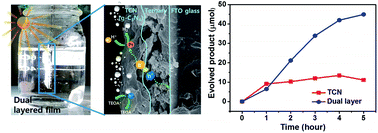Evaluation of dual layered photoanode for enhancement of visible-light-driven applications†
Abstract
Ternary structures consisting of hollow g-C3N4 nanofibers/MoS2/sulfur, nitrogen-doped graphene and bulk g-C3N4 (TCN) were designed as a dual layered film and fabricated using a spin-coating method. The first ternary structures were spin-coated on fluorine-doped tin oxide (FTO) glass, followed by spin-coating of g-C3N4 film to form dual layers. We characterized the microstructural morphologies, chemical composition/bonding and optical properties of the dual layered film and observed significantly reduced recombination rates of photo-induced electron–hole pairs due to effective separation of the charge carriers. We tested methylene blue (MB) photodegradation and observed remarkable MB degradation by the dual layered film over 5 hours, with a kinetic rate constant of 1.24 × 10−3 min−1, which is about four times faster than that of bare TCN film. Furthermore, we estimated the H2 evolution of the dual layered film to be 44.9 μmol over 5 hours, and carried out stable recycling over 45 hours under visible irradiation. Due to the lower electrochemical impedance spectroscopy (EIS) resistance value of the dual layered film (∼50 ohm cm2) compared to the TCN film, the ternary structures and bulk g-C3N4 film were well-connected as a heterojunction, reducing the resistance at the interface between the film and the electrolyte. These results indicate that the effective separation of the photo-induced electron–hole pairs using the dual layered film dramatically improved its photo-response ability under visible light irradiation.



 Please wait while we load your content...
Please wait while we load your content...